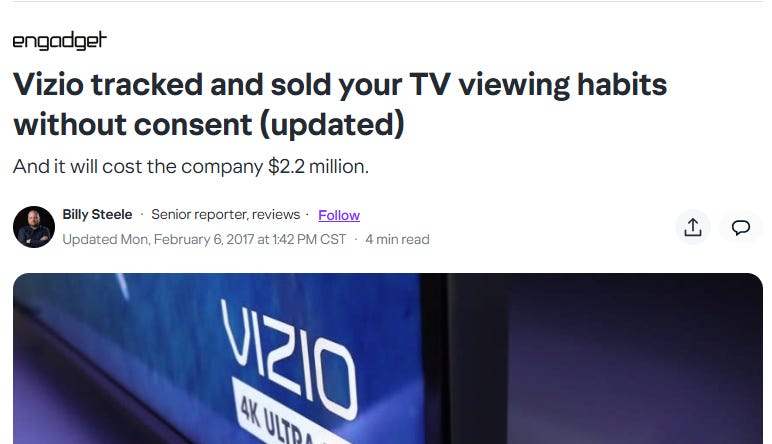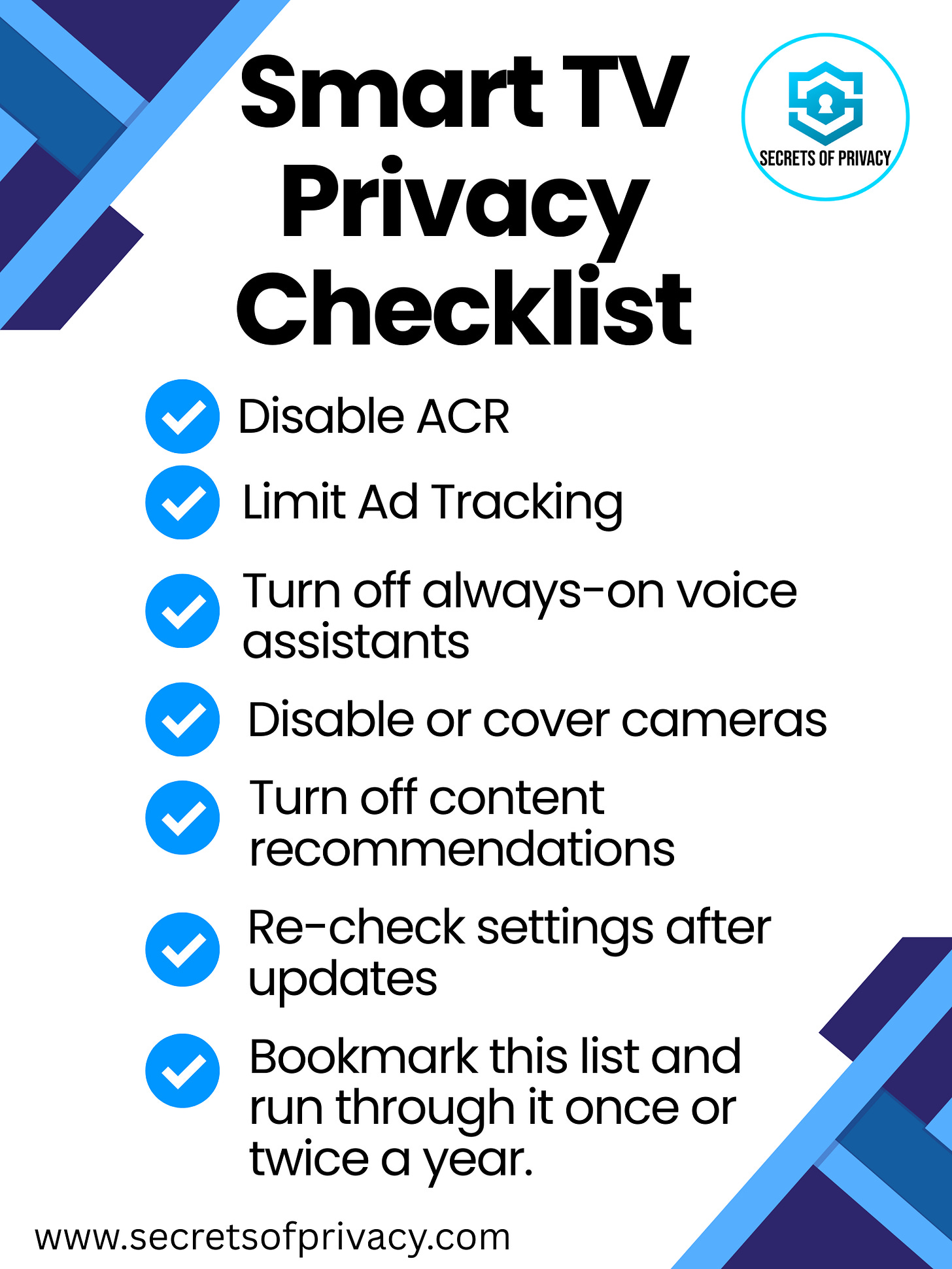How to Make Your Smart TV Less creepy (Part 1)
Smart TV privacy explained: real-world risks and the easy wins
Most people don’t think of their living room as a place where they’re being surveilled. But if you own a smart TV, that’s exactly what’s happening.
Modern TVs aren’t just screens. They’re data collectors. From the moment you turn them on, they can log what you watch, when you watch it, and even what other devices are on your Wi-Fi. Much of this information gets sold to advertisers and data brokers.
This first part of our guide will explain the main risks and show you how to take control using the settings already on your TV. In Part 2, we’ll cover advanced defenses like network filtering and external devices.
Why TV Makers Track You
The global smart TV ad market is booming. In 2024, advertisers spent an estimated $30 billion on “connected TV advertising”, and the number is climbing every year. That money is because of your data.
Your viewing history is a goldmine for advertisers because it can be linked to other identifiers, like your email address, IP address, or even your physical street address. Once tied together, that profile doesn’t just power ads on your TV. It follows you across phones, laptops, and tablets.
What Data Your Smart TV Collects
When you set up a smart TV, you’re not just turning on a screen. You’re agreeing to let it capture and share a surprising amount of personal data. Depending on the brand and model, this can include:
Viewing history: Every show, movie, or ad you watch, often down to the second.
Screenshots of content: ACR technology can capture images of what’s on the screen to match against a database.
Device identifiers: Things like your TV’s unique ID, MAC address, and serial number.
Network data: Your IP address and sometimes details of your home Wi-Fi environment.
Location data: Approximated from your IP or ZIP code entered during setup.
Personal information: Names, email addresses, and in some cases phone numbers tied to your account.
Voice recordings: If voice assistants are enabled, snippets of conversations captured by the microphone.
App usage: Which apps you open, how often, and what you do inside them.
This data doesn’t just stay with the TV manufacturer. It’s often shared with advertisers, analytics firms, and the dreaded data brokers, where it can be linked to your broader digital footprint.
In the age of extreme AI, starving the data brokers of your data is critically important to protecting your privacy and physical security. It’s one of the reasons we regularly recommend getting a data broker removal service to automatically remove your data from these terrible sites. We’ve used DeleteMe for the past five years or so and can’t recommend it enough. Learn more here.
The Biggest Privacy Risks Hiding In Your TV
Before diving into the specific features, it helps to understand the bigger picture. Smart TVs are designed to act more like computers than traditional televisions. That means every function, whether it’s streaming a show, using a voice command, or browsing menus, creates data that can be collected, stored, and shared.
Some of this is harmless, but much of it is tied directly to advertising and profiling. Here are the biggest risks you’ll want to know about.
Automatic content recognition (ACR)
ACR is built into most smart TVs as a way to monitor what you watch. It works by capturing tiny samples of what’s on your screen, either still images or snippets of audio, and comparing them against a massive database of TV shows, movies, and ads. Once there’s a match, your viewing history gets logged and linked to your household.
That means if you watch a Netflix series, a cable broadcast, or even a DVD, the TV can record it. Manufacturers then package that data and share it with advertisers, who use it to target you with personalized ads or combine it with other information (like your email or IP address) to build a more detailed profile.
Real-world example:
In 2017, Vizio paid $2.2 million to settle FTC charges after secretly collecting and selling viewing histories of 11 million TVs without consent.
Voice assistants and microphones
Many TVs now ship with “Hey Google,” Alexa (Amazon), or Bixby (Samsung) built in. That means microphones are listening for commands. In practice, they can also capture background conversations. Those recordings often leave your home for cloud processing, and in some cases have been reviewed by actual live humans.
If you don’t actively use the feature, make sure the microphone and voice assistant are turned off by default. Some TVs enable them during setup without making it obvious, so it’s worth double-checking your settings.
Cameras
Certain models include cameras for gesture control or video calls. If hacked or left unsecured, a living room camera poses obvious risks. You probably wouldn’t even know if it’s turned on. Cover it with tape if you can’t disable it.
App-level and system tracking
Even if you turn off ACR, your TV logs which apps you open, when you use them, and sometimes what else is connected to your Wi-Fi. Streaming apps like Netflix or YouTube also run their own tracking, independent of TV settings.
Settings that reset themselves
Many readers don’t realize this: after a firmware update, your privacy choices may get reverted back to defaults. That means data collection silently switches back on. It’s annoying, but you may want to set a recurring reminder in your to-do tracker to check this periodically.
Where to Find the Settings On Popular Brands
Every manufacturer buries these options in slightly different menus. Here’s a quick map for the most common ones as of publication:
Samsung: Settings > Privacy Choices > Viewing Information Services
LG: Settings > General > System > Additional Settings > Live Plus
Sony: Settings > Initial Setup > Samba Interactive TV
Hisense: Settings > System > Privacy > Viewing Information Services
TCL (Roku): Settings > Privacy > Smart TV Experience > Use Info from TV Inputs
Vizio: Settings > System > Reset & Admin > Viewing Data
Look for terms like:
ACR
Live Plus
Viewing Data
Samba
Smart TV Experience.
All of these are just different labels for the same tracking technology.
The Easy Wins: Settings to Change Today
Here are the biggest switches you can flip for a more private setup:
Turn off ACR. Stop the real-time screenshotting of everything you watch.
Limit ad tracking. In the Privacy or Advertising menu, enable “Limit Ad Tracking” and disable “Personalized Ads.”
Shut off voice assistants if you don’t use them. Disable Alexa, Google Assistant, Bixby, or any “always listening” features. Most remotes still allow push-to-talk when you press a button.
Disable cameras. If your TV has one and you don’t need it, turn it off in settings (or cover it).
Turn off content recommendations and promotions. These are just ads by another name.
Revisit after updates. Firmware can reset privacy settings, so check once in a while.
The Trade-Offs
Turning off these features may make your TV feel a little less “smart.” You’ll see fewer content recommendations and won’t get personalized ads. Voice commands may stop working if you disable the mic. But you’ll still be able to stream, watch cable, or use connected devices exactly as before.
For most people, this is a high privacy ROI move: you lose very little convenience while cutting off a major data pipeline from your living room.
Why This Matters
Television used to be private. Now it’s another data stream feeding Big Tech.
By disabling ACR and tightening a few settings, you make your TV a harder target for surveillance. It’s one of the easiest privacy wins you can stack this week.
In Part 2, we’ll go deeper, covering advanced defenses like DNS filtering, Pi-hole, external streaming devices, and whether it’s time to ditch the “smart” features altogether. Then in Part 3, we’ll look at the streaming devices themselves (Roku, Fire TV, Apple TV, and Chromecast) and show how to rein in their tracking too.
Friendly Ask
If you found this helpful or informative, chances are your friends and family will as well. Especially those with a Smart TV. Please share it with them to help spread awareness.
Other Parts in this Series on How to Make Your Smart TV Less Creepy:
Part 3 will be released on September 30, 2025.
Looking for help with a privacy issue or privacy concern? Chances are we’ve covered it already or will soon. Follow us on X and LinkedIn for updates on this topic and other internet privacy related topics.
Disclaimer: None of the above is to be deemed legal advice of any kind. These are *opinions* written by a privacy and tech attorney with years of working for, with and against Big Tech and Big Data. And this post is for informational purposes only and is not intended for use in furtherance of any unlawful activity. This post may also contain affiliate links, which means that at no additional cost to you, we earn a commission if you click through and make a purchase.
Privacy freedom is more affordable than you think. We tackle the top Big Tech digital services and price out privacy friendly competitors here. The results may surprise you.
If you have an iPhone, you’ll want to check out this post:
Check out our specialized privacy and security guides in our digital shop. Below is a sample of what’s available. People are really loving the De-Google your Life Guide (available here at 25% off). Browse all the guides here.
If you’re reading this but haven’t yet signed up, join for free (3.5K+ subscribers strong) and get our newsletter delivered to your inbox by subscribing here 👇








Looking forward to part 2 where you talk about things like Roku, Apple TV, Firestick and more.
It's hard to buy a tv that isn't a smart tv anymore.
I've chosen to not connect them to my network. I use Apple TV and Roku streaming devices. Which is why I'm looking forward to part 2!
Thank you so much for your very helpful and generous advice. As a non-techie consumer, I’m truly grateful when someone not only identifies problems that are built into smart technology; but, gives me strategies for maintaining my privacy.